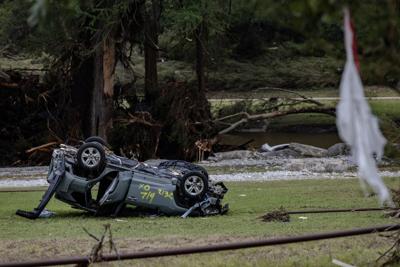In the anthology of extreme weather exacerbated by climate change, few events are more horrific than flash floods.
A hard rain is funnelled by steep slopes, transforming brooks into creeks, creeks into rivers and rivers into raging torrents that rip trees out by their roots and tear houses from their foundations creating a moving debris field of death.
In Texas, this geographic multiplier effect turned 20 inches of rain into a 26-foot rise in the Guadalupe River in only 45 minutes.
ItÔÇÖs no wonder that flash flooding has been called a ÔÇťrain bomb.ÔÇŁ
Floodwaters forced people to escape their homes by swimming out windows, only to find themselves caught up in a maelstrom, dodging floating cars and telephone poles. More than 80 people have been killed, including 28 children at a summer camp, and officials warn the death toll could rise as more missing are found.
Are flash floods getting worse?
While flash floods are not uncommon and have long occurred around the world, theyÔÇÖre getting more destructive and deadly due to a confluence of three factors: climate change, population growth and land use, according to Slobodan Simonovic, professor of civil engineering at Western University and director of engineering studies at the university’s Institute for Catastrophic Loss Reduction.
ÔÇťThe physics is very clear: with global warming, you have higher temperatures, you are storing much more moisture in the air, and that moisture comes back in the form of very intensive storms,ÔÇŁ he said. ÔÇťCombine that with the geography of the region that makes things worse: Steep hills, rocky land, no absorption at all. So the rain flows very fast into the creeks and rivers, raising the water levels.
ÔÇťAdd land use and populations living in high-risk areas and you donÔÇÖt just have a flooding event, you have a disaster,ÔÇŁ he said.
Are flash floods getting more frequent?
Due to its steep valleys and limestone bedrock that prevents the soil from absorbing the rain, Hill Country in Texas has a long history of deadly flash floods, they have also recently hit areas less habituated to the risk, such as Germany and Austria.
ÔÇťIf you look down the road and follow these big events, it is becoming very clear that we are seeing them much more often. And they’re becoming much more serious,ÔÇŁ Simonovic added.
In Canada, parts of the Rocky Mountains are at risk of flash flooding, though Simonovic stressed few people live in the affected areas.
Can you prepare for a flash flood?
Unlike regular flooding, which can be mitigated with sump pumps, or wildfires where you can help protect your house by installing a metal roof or clearing back the bush, itÔÇÖs basically impossible to prepare for a flash flood┬áÔÇö all you can do is flee.
As a result the best preparation is good forecasting and sending out early warning.
ÔÇťYou gain time by providing information early so that you can evacuate people from the potential areas that will be affected,ÔÇŁ Simonovic said.
But accurate prediction and adequate warning are very complex problems, said Reza Najafi, a professor of civil engineering and head of the Hydroclimate Extremes and Climate Change Lab at Western University.
ÔÇťWhile improvements in forecasting have helped, we often get the magnitudes wrong and what may have been predicted as a heavy rain becomes a torrential storm,ÔÇŁ he said.
‘A complex problem┬áÔÇö and a global one’
While flood warnings get issued, they often donÔÇÖt get to the most affected people, or if they do, those people often ignore them.
ÔÇťIf you live in Texas where flooding happens so often, you may underestimate the coming weather, thinking you live far enough away from the river to be safe,ÔÇŁ said Najafi. ÔÇťConversely, in areas that have not experienced flooding events┬áÔÇö like in Dubai, which had a major flood last year even though itÔÇÖs in a desert┬áÔÇö┬ápeople donÔÇÖt know what to do.ÔÇŁ
ÔÇťThis is a complex problem ÔÇö and a global one,ÔÇŁ he added.
Climate change is not only increasing the frequency of extreme precipitation events, itÔÇÖs also pushing them into areas where theyÔÇÖve never happened before, he said.
Areas where impermeable concrete and pavement mimic rocky soil┬áÔÇö like cities┬áÔÇö are at much higher risk for flash flooding in the future.


























To join the conversation set a first and last name in your user profile.
Sign in or register for free to join the Conversation